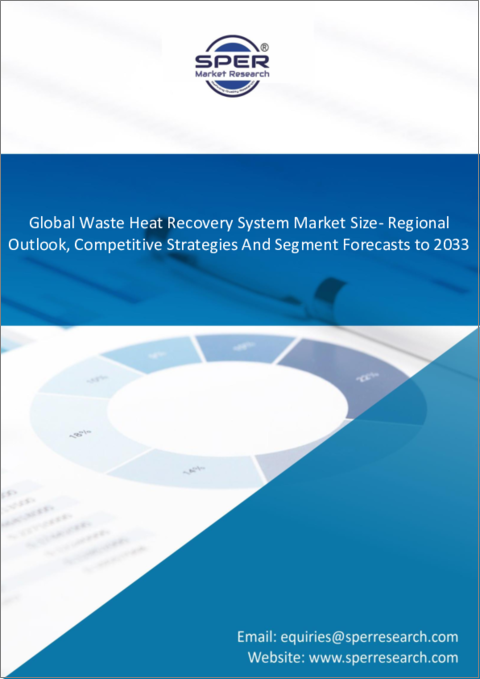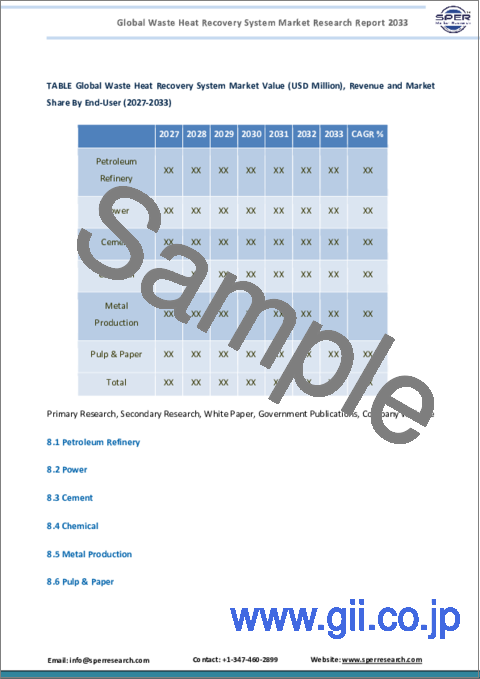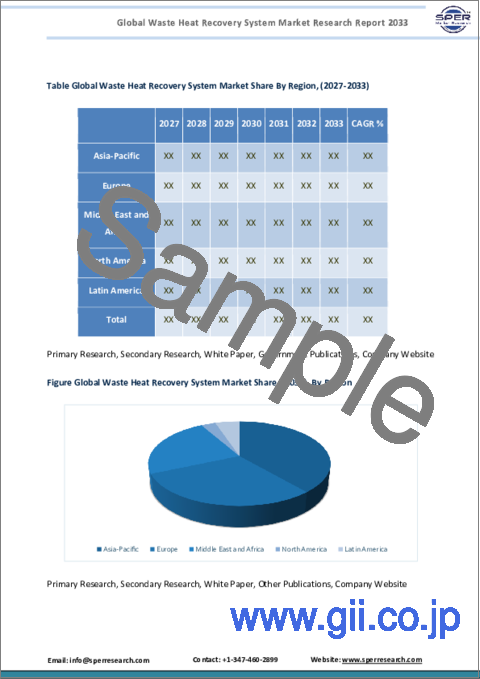|
|
市場調査レポート
商品コード
1229646
廃熱回収システムの世界市場:市場規模 - 用途別、エンドユーザー別、地域別展望、競合戦略、セグメント別予測(~2032年)Waste Heat Recovery System Market Size- By Application, By End-User- Regional Outlook, Competitive Strategies and Segment Forecast to 2032 |
||||||
| 廃熱回収システムの世界市場:市場規模 - 用途別、エンドユーザー別、地域別展望、競合戦略、セグメント別予測(~2032年) |
|
出版日: 2023年02月16日
発行: SPER Market Research Pvt. Ltd.
ページ情報: 英文 254 Pages
納期: 即日から翌営業日
|
- 全表示
- 概要
- 目次
世界の廃熱回収システムの市場規模は、2032年までに1,672億7,000万米ドルに達し、CAGRで9.04%の成長が予測されています。市場は、エネルギー価格の上昇、エネルギー効率に関する政府の厳しい規制、持続可能なエネルギーソリューションの必要性に対する意識の高まりなどの要因によって牽引されています。
当レポートでは、世界の廃熱回収システム市場について調査し、市場力学、市場変数と展望、競合情勢、用途・エンドユーザー・地域別の市場分析、企業プロファイル等に関する情報を提供しています。
目次
第1章 イントロダクション
- 調査範囲
- 市場セグメント分析
第2章 調査手法
- 調査データソース
- 市場規模の推定
- データの三角測量
第3章 エグゼクティブサマリー
第4章 市場力学
- 促進要因、抑制要因、機会、課題の分析
- 促進要因
- 抑制要因
- 機会
- 課題
- 世界の廃熱回収システム市場におけるCOVID-19の影響
第5章 市場変数と展望
- SWOT分析
- 強み
- 弱み
- 機会
- 脅威
- PESTEL分析
- 政治情勢
- 経済情勢
- 社会情勢
- 技術情勢
- 環境情勢
- 法的情勢
- ポーターのファイブフォース分析
- 供給企業の交渉力
- 買い手の交渉力
- 代替品の脅威
- 新規参入者の脅威
- 競合企業間の敵対関係
- ヒートマップ分析
第6章 競合情勢
- 世界の廃熱回収システム市場の製造拠点分布、販売エリア、製品タイプ
- 世界の廃熱回収システム市場における合併・買収、パートナーシップ、製品発売、コラボレーション
第7章 世界の廃熱回収システム市場:用途別(2019年~2032年(100万米ドル))
- 予熱
- 蒸気・発電
- その他
第8章 世界の廃熱回収システム市場:エンドユーザー別(2019年~2032年(100万米ドル))
- 石油精製所
- 電力
- セメント
- 化学
- 金属生産
- パルプ・紙
- その他
第9章 世界の廃熱回収システム市場:地域別(2019年~2032年(100万米ドル))
- 世界の廃熱回収システムの市場規模と市場シェア:地域別(2019年~2025年)
- 世界の廃熱回収システムの市場規模と市場シェア:地域別(2026年~2032年)
- アジア太平洋
- オーストラリア
- 中国
- インド
- 日本
- 韓国
- その他のアジア太平洋
- 欧州
- フランス
- ドイツ
- イタリア
- スペイン
- 英国
- その他の欧州
- 中東・アフリカ
- サウジアラビア王国
- アラブ首長国連邦
- その他の中東・アフリカ
- 北米
- カナダ
- メキシコ
- 米国
- ラテンアメリカ
- アルゼンチン
- ブラジル
- その他のラテンアメリカ
第10章 企業プロファイル
- ABB
- 企業概要
- 財務展望
- 製品概要
- 最近の開発
- AURA GmbH & Co.
- Bosch Industriekessel GmbH
- Boustead International Heaters
- Climeon
- Exergy S.p.A
- Forbes Marshall
- General Electric
- Terrapin
- Siemens AG
第11章 略語一覧
第12章 参照リンク
第13章 結論
第14章 調査範囲
Global Waste Heat Recovery System Market Overview
According to SPER Market Research, the Global Waste Heat Recovery System Market is estimated to reach USD 167.27 billion by 2032 with a CAGR of 9.04%.
The Waste Heat Recovery System (WHRS) market refers to the collection and utilization of industrial heat that is otherwise lost as a byproduct of various processes. This heat energy can be captured and transformed into useful energy, such as electricity or steam, providing a cost-effective and environmentally friendly solution for energy generation. The market for WHRS is driven by factors such as increasing energy prices, stringent government regulations on energy efficiency, and the growing awareness of the need for sustainable energy solutions. The market is composed of various products, such as heat exchangers, boilers, and turbines, which are used in a range of industries, including chemical, oil and gas, and power generation. The global market for WHRS is expected to grow significantly in the coming years, driven by the increasing demand for energy efficiency and the need to reduce greenhouse gas emissions.
Impact of COVID-19 on the Global Waste Heat Recovery System Market
The COVID-19 pandemic has had an impact on the waste heat recovery system market, similar to other industries. The pandemic has caused widespread economic disruption, reducing demand for waste heat recovery systems as investment and spending on industrial projects decreased. The pandemic has also disrupted supply chains, causing difficulties for waste heat recovery system providers in terms of securing raw materials and maintaining production levels.
However, despite these challenges, the long-term outlook for the waste heat recovery system market remains positive. As the world begins to recover from the pandemic and economic activity resumes, demand for waste heat recovery systems is expected to pick up, driven by growing concerns about energy efficiency and reducing carbon emissions. The government has taken steps to support the sector, such as increasing investment in clean energy projects and promoting the adoption of sustainable technologies. Additionally, the pandemic has accelerated the adoption of digital technologies, creating new opportunities for waste heat recovery system providers to improve their operations and better meet the needs of their customers.In conclusion, while the COVID-19 pandemic has had a short-term impact on the waste heat recovery system market, the sector is expected to recover and continue to grow in the coming years as the focus on energy efficiency and sustainability remains a priority.
Scope of the Report
Report Metric Details:
Market size available for years 2019-2032
Base year considered 2021
Forecast period 2022-2032
Segments covered By Application, By End-User
Regions covered Asia-Pacific, Europe, Middle East and Africa, North America, Latin America
Companies Covered General Electric, ABB, Boustead International Heaters, Forbes Marshall, Terrapin, Climeon, Bosch Industriekessel GmbH, AURA GmbH & Co., Exergy S.p.A.
Global Waste Heat Recovery System Market Segmentation:
By Application: Based on the Application, Global Waste Heat Recovery System Market is segmented as; Pre Heating, Steam & Electricity Generation, Others.
By End-User: Based on End-User, Global Waste Heat Recovery System Market is segmented as; Petroleum Refinery, Power, Cement, Chemical, Metal Production, Pulp & Paper, Others.
By Region: This report also provide the data for key regional segments across the globe: Asia-Pacific, Europe, Middle East and Africa, North America, Latin America.
Table of Contents
1. Introduction
- 1.1. Scope of the report
- 1.2. Market segment analysis
2. Research Methodology
- 2.1 Research data source
- 2.1.1 Secondary data
- 2.1.2 Primary data
- 2.1.3 SPER's internal database
- 2.1.4 Premium insight from KOL's
- 2.2 Market size estimation
- 2.2.1 Top-down and Bottom-up approach
- 2.3 Data triangulation
3. Executive Summary
4. Market Dynamics
- 4.1. Driver, Restraint, Opportunity and Challenges analysis
- 4.1.1 Drivers
- 4.1.2 Restraints
- 4.1.3 Opportunities
- 4.1.4 Challenges
- 4.2. COVID-19 Impacts of the Global Waste Heat Recovery System Market
5. Market variables and outlook
- 5.1. SWOT analysis
- 5.1.1 Strengths
- 5.1.2 Weaknesses
- 5.1.3 Opportunities
- 5.1.4 Threats
- 5.2. PESTEL analysis
- 5.2.1 Political landscape
- 5.2.2 Economic landscape
- 5.2.3 Social landscape
- 5.2.4 Technological landscape
- 5.2.5 Environmental landscape
- 5.2.6 Legal landscape
- 5.3. PORTER'S five forces analysis
- 5.3.1 Bargaining power of suppliers
- 5.3.2 Bargaining power of Buyers
- 5.3.3 Threat of Substitute
- 5.3.4 Threat of new entrant
- 5.3.5 Competitive rivalry
- 5.4. Heat map analysis
6. Competitive Landscape
- 6.1 Global Waste Heat Recovery System Market Manufacturing Base Distribution, Sales Area, Product Type
- 6.2 Mergers & Acquisitions, Partnerships, Product Launch, and Collaboration in Global Waste Heat Recovery System Market
7. Global Waste Heat Recovery System Market, By Application, 2019-2032 (USD Million)
- 7.1 Pre Heating
- 7.2 Steam & Electricity Generation
- 7.3 Others
8. Global Waste Heat Recovery System Market, By End-User, 2019-2032 (USD Million)
- 8.1 Petroleum Refinery
- 8.2 Power
- 8.3 Cement
- 8.4 Chemical
- 8.5 Metal Production
- 8.6 Pulp & Paper
- 8.7 Others
9. Global Waste Heat Recovery System Market, By Region, 2019-2032 (USD Million)
- 9.1 Global Waste Heat Recovery System Market Size and Market Share by Region (2019-2025)
- 9.2 Global Waste Heat Recovery System Market Size and Market Share by Region (2026-2032)
- 9.3 Asia-Pacific
- 9.3.1 Australia
- 9.3.2 China
- 9.3.3 India
- 9.3.4 Japan
- 9.3.5 South Korea
- 9.3.6 Rest of Asia-Pacific
- 9.4 Europe
- 9.4.1 France
- 9.4.2 Germany
- 9.4.3 Italy
- 9.4.4 Spain
- 9.4.5 United Kingdom
- 9.4.6 Rest of Europe
- 9.5 Middle East and Africa
- 9.5.1 Kingdom of Saudi Arabia
- 9.5.2 United Arab Emirates
- 9.5.3 Rest of Middle East & Africa
- 9.6 North America
- 9.6.1 Canada
- 9.6.2 Mexico
- 9.6.3 United States
- 9.7 Latin America
- 9.7.1 Argentina
- 9.7.2 Brazil
- 9.7.3 Rest of Latin America
10. Company Profiles
- 10.1 ABB
- 10.1.1 Company details
- 10.1.2 Financial outlook
- 10.1.3 Product summary
- 10.1.4 Recent developments
- 10.2 AURA GmbH & Co.
- 10.2.1 Company details
- 10.2.2 Financial outlook
- 10.2.3 Product summary
- 10.2.4 Recent developments
- 10.3 Bosch Industriekessel GmbH
- 10.3.1 Company details
- 10.3.2 Financial outlook
- 10.3.3 Product summary
- 10.3.4 Recent developments
- 10.4 Boustead International Heaters
- 10.4.1 Company details
- 10.4.2 Financial outlook
- 10.4.3 Product summary
- 10.4.4 Recent developments
- 10.5 Climeon
- 10.5.1 Company details
- 10.5.2 Financial outlook
- 10.5.3 Product summary
- 10.5.4 Recent developments
- 10.6 Exergy S.p.A
- 10.6.1 Company details
- 10.6.2 Financial outlook
- 10.6.3 Product summary
- 10.6.4 Recent developments
- 10.7 Forbes Marshall
- 10.7.1 Company details
- 10.7.2 Financial outlook
- 10.7.3 Product summary
- 10.7.4 Recent developments
- 10.8 General Electric
- 10.8.1 Company details
- 10.8.2 Financial outlook
- 10.8.3 Product summary
- 10.8.4 Recent developments
- 10.9 Terrapin
- 10.9.1 Company details
- 10.9.2 Financial outlook
- 10.9.3 Product summary
- 10.9.4 Recent developments
- 10.10 Siemens AG
- 10.10.1 Company details
- 10.10.2 Financial outlook
- 10.10.3 Product summary
- 10.10.4 Recent developments




